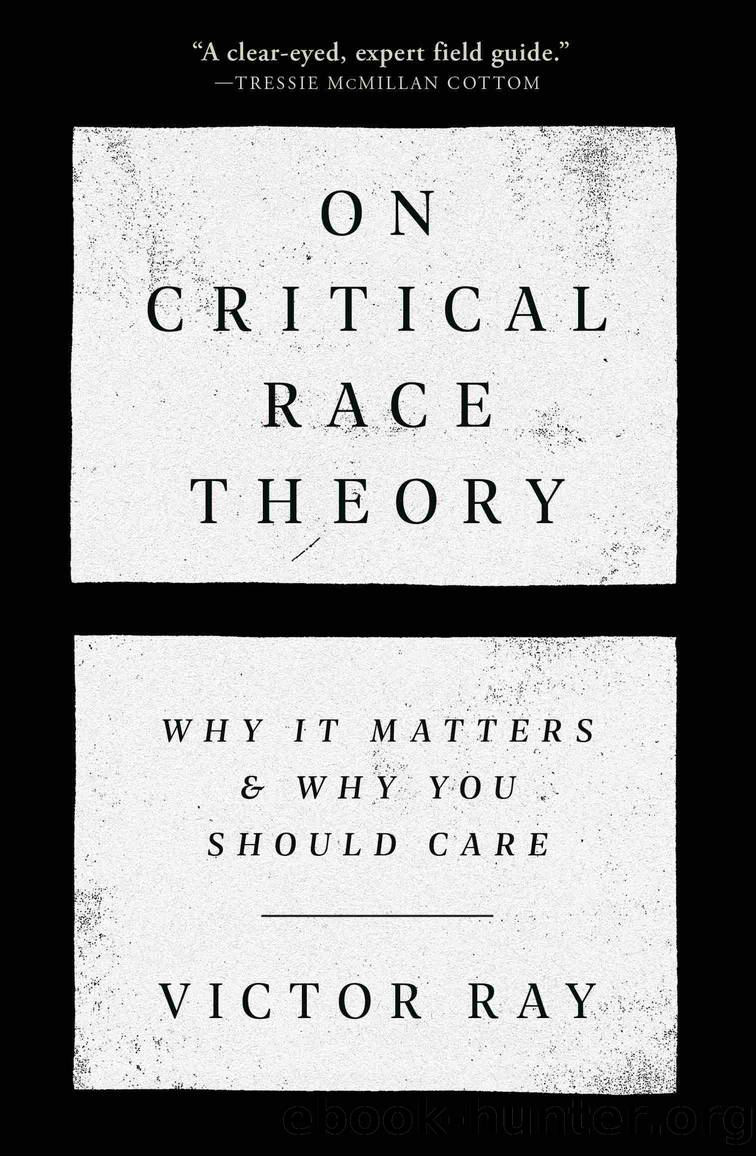On Critical Race Theory by Victor Ray

Author:Victor Ray [Ray, Victor]
Language: eng
Format: epub
Publisher: Random House Publishing Group
Published: 2022-08-02T00:00:00+00:00
CHALLENGING AMERICAâS DOMINANT STORIES
The stories America tells about itself are weighted on a racial âhierarchy of credibility,â as the sociologist Howard Becker described our propensity to believe those with greater power or higher status.[9] Messages are not interpreted independently of the messenger, and those at the top of social hierarchies, such as bosses in the workplace, professors during lectures, or generals in the military, are typically given deference. In the workplace or classroom, refusing to fall in line and accept the view of reality dictated from the top results in getting fired or failed. Anyone who has worked for a boss knows that those at the top of a hierarchy arenât always correct and donât always know whatâs best. Bosses, generals, and professors routinely make errors. It isnât the bossesâ ideas, the generalsâ charisma, or the professorsâ wit but their relative power that compels obedience.
Hierarchies of credibility distort reality because they encourage believing the powerful and discounting the accounts of the relatively powerless, the marginalized, or social outcasts. Racism is a hierarchical system whose victims are disempowered, dehumanized, and disbelieved. Discounting the voices of the racially marginalized was (and remains) a feature of the American legal system. Prior to the passing of the Fourteenth Amendment, the enslaved couldnât testify against their enslavers, and in some free states, Black people couldnât testify against whites.[10] Jim Crow laws often ensured that Black peopleâs testimonies were either inadmissible or easily ignored (if, indeed, Black people were brave enough to testify against whites because doing so could get them murdered). Notorious all-white juries acquitted unquestionably guilty white lynching partiesâsuch as Emmett Tillâs killersâwhen they were brought to trial at all.[11] Such acquittals arenât historical relics of less enlightened times. Narratives of Black criminality and white fear were central to the not-guilty verdict that let George Zimmerman walk after he killed Trayvon Martin and to former officer Darren Wilson facing no charges after shooting Mike Brown.
The sense that Black people canât be objective on race matters leads to their legal exclusion from juries. Although the Supreme Court ruled it unconstitutional to bar a juror based on their race in Batson v. Kentucky, some prosecutors have developed an array of creative colorblind excuses for removing nonwhites.[12] According to Gilad Edelman, the farce of race neutrality in juror removals for traits like âtoo old, too young; living alone, living with a girlfriendâ led one Illinois judge to quip, âNew prosecutors are given a manual, probably entitled, âHandy Race-Neutral Explanationsâ or â20 Time-Tested Race-Neutral Explanations.âââ[13] Excluding Black jurors isnât a hypothetical harm, as juries drawn from all-white pools are 16 percent more likely to convict Black defendants. Including just one Black person in a jury pool eliminates this disparity.[14] Racial hierarchies of credibility also shape courtroom interactions. As sociologist Nicole Gonzalez Van Cleve shows in her critical race analysis of Chicagoâs Cook County courthouses, judges and prosecutors routinely subject Black and Latino defendants to dehumanizing âracial degradation ritualsâ that undermine their testimonies, for instance by mocking Black vernacular English or Black names.
Download
This site does not store any files on its server. We only index and link to content provided by other sites. Please contact the content providers to delete copyright contents if any and email us, we'll remove relevant links or contents immediately.
| Civil Rights | Discrimination |
| General | Human Rights |
Day by Elie Wiesel(2721)
The Age of Genius by A. C. Grayling(2544)
Gideon's Spies: The Secret History of the Mossad by Gordon Thomas(2305)
The Gulag Archipelago (Vintage Classics) by Aleksandr Solzhenitsyn(2048)
FATWA: Hunted in America by Pamela Geller(1972)
Columbine by Dave Cullen(1823)
Men Explain Things to Me by Rebecca Solnit(1694)
The Rule of Law by Bingham Tom(1651)
Anatomy of Injustice by Raymond Bonner(1621)
Examples & Explanations: Administrative Law by William F. Funk & Richard H. Seamon(1604)
Three Cups of Tea by Greg Mortenson(1580)
That Every Man Be Armed by Stephen P. Halbrook(1549)
The Source by James A. Michener(1540)
ADHD on Trial by Michael Gordon(1532)
Gideon's Spies by Gordon Thomas(1472)
Future Design by Unknown(1471)
Palestinian Walks by Raja Shehadeh(1459)
Constitutional Theory by Carl Schmitt(1414)
Nothing to Envy by Barbara Demick(1388)
